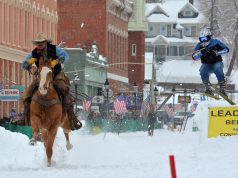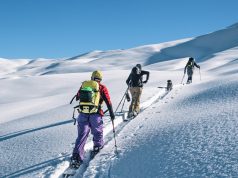
The Book is a result of sweat. Of struggle. Of pain and mishap and, ultimately, of success. The Book is, says Palmer Hoyt, “how I learned how to ski again.”
Hoyt is no ordinary skier. The coach of the Colorado Freestyle Ski team is an accomplished athlete — as you would expect of the guy who is leading the defending national champions — and he’s a ripping skier. But he’s also an intellectual. The guy who was smart and motivated enough to write The Book.
But before we talk about The Book, and the long road that Hoyt took, we should first talk about the University of Colorado’s Freestyle program. Hoyt has overseen the team since 2005. Last year the team clinched its third national championship. It’s a program built on success and dedication. As a club sport there’s precious little funding for the organization from CU and even less recognition in the media.
“We get minimal support from CU,” says Hoyt. “About 25 percent of the actual costs come from the athletes, fundraising is always a challenge and, of course, there’s the substantial cost of skiing.”
Still, the team has some factors working in its favor.
“Everyone comes to CU to ski,” notes Hoyt, saying that Boulder in general and the university in particular attracts a wealth of talented youngsters who are at home on snow.
While the team originally started to cater to mogul skiers who had no place in CU’s powerhouse alpine racing program, the offerings on tap have evolved as the sport of skiing has changed. Today a comprehensive freestyle program includes big-mountain, park, bigair and halfpipe coaching. The latter is bolstered by the inclusion of halfpipe skiing in the 2014 Winter Olympics, hosted by Sochi, Russia.
Photo by Larry Pierce
With the exception of big-mountain events, competitions are sanctioned by the United States Skiing Association (USSA), the same governing body that oversees more traditional disciplines such as mogul skiing and alpine racing. Athletes compete in United States Skiing Association events across the Rocky Mountain region and in collegiate events sanctioned by the United States Collegiate Ski and Snowboard Association (USCSA).
According to Hoyt, the athlete mix is about 50-50 between big-mountain athletes (who this year will be competing in Freeride World Tour qualifying events overseen and sanctioned by the Freeride World Tour, big-mountain skiing’s global event organization, and which are separate from National Championship boasting rights) and the United States Skiing Association athletes who will be showcasing their skills at the association’s slopestyle and halfpipe events as well as events sanctioned by the United States Collegiate Ski and Snowboard Association.
With a fourth national championship up for grabs, you can expect these athletes to lay it on the line. But what you won’t know is that their ability to do so, safely and at the highest levels of competition, is based on The Book.
The Book is an accident. Literally. Hoyt, a competitive mogul skier, was en route to an event when his car became stuck on a high mountain road in an intense blizzard. While working in the whiteout to get his vehicle moving again, Hoyt was struck by a snowplow. The injuries were intense and lifethreatening. Hoyt had to learn to walk again, and doctors told him it was doubtful that he’d ever be able ski at the levels he enjoyed prior to the accident. Hoyt was not deterred, and started to work on regaining his skills.
“I had to teach myself to ski again,” he says. “I wrote the book for myself, to break down the fundamentals of skiing, and relearn the sport step by step.”
The result is a slender tome with the acronym SAFE. It is a unique instructional manual that was born out of the rehabilitation challenges Hoyt faced after his up-close and personal encounter with a snowplow. SAFE stands for Strength, Agility, Flexibility and Endurance, the four pillars of the foundation that Hoyt created to reignite his skiing career, and the fundamentals that he used to coach his CU athletes to two national championships (one of the three preceded this new method).
Palmer Hoyt | Photo by Jack Affleck
According to Hoyt, by breaking down skiing into basic movements while also focusing on the physical attributes — from agility to strength — needed to compete at the highest levels, everyone from raw beginners to the most seasoned experts can improve as skiers. By implementing the SAFE program during preseason training, Hoyt says that the CU athletes he coaches go into the season well-prepared. With more strength and agility, they ski better, while the emphasis on flexibility and endurance means that they’re less prone to injury. And the fact that the team is the defending national champion speaks to the effectiveness of the program.
Still, despite the glory that comes with winning national championships, Hoyt is quick to point out that he’s merely continuing down a road of success that was paved by those who preceded him.
“The work that was done before me allowed me to create the current infra structure of the team,” he says. Noting that while athletic success is nice, the team has always had a tradition of focusing on success as a much bigger concept than merely taking home medals.
“They are skiers and they’re college kids,” he says, laughing. “Of course they’re going to get rowdy. But our coaches provide role models and leadership to the kids. We teach them that by using self discipline they can succeed not just as skiers but as people.”
And for Hoyt, it’s the latter that is more important than any other element in the program.
“Skiing can be used as a metaphor for life,” he says. “You break the fundamentals down and then start to work on the little things. We make it a point to the athletes that you can always improve.”
With three national championships in the bag, CU is the favorite to take top honors again this year. But as nice as a repeat would be, Hoyt will be just as happy if his athletes find success in the most important event of all, the game of life.
“The aim is to create not just great skiers,” Hoyt says. “But to create great skiers who also contribute to society.”
Respond: [email protected]














